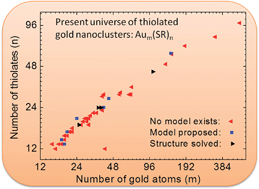 “Thiolated gold nanoclusters form a universe of their own”, writes De-en Jiang in the first line of his recent feature article in this field. Jiang’s article provides a fascinating tour through this ever-expanding cosmos from the point of view of a computational chemist.
“Thiolated gold nanoclusters form a universe of their own”, writes De-en Jiang in the first line of his recent feature article in this field. Jiang’s article provides a fascinating tour through this ever-expanding cosmos from the point of view of a computational chemist.
A great challenge for computational chemists is to predict the most stable structure for a thiolated gold nanocluster with a given composition. There are just a few experimentally resolved structures and these provide important hints for the structures of many identified compositions that have yet to be crystallised or structurally determined. Jiang describes computational approached to predict these structures, in particular the powerful “staple hypothesis”, which can help predict how the staple motifs are arranged on the core surface.
It is not fair to say that this article is simply an intergalactic tour. Jiang also further pushes the boundaries of the Universe in his article by presenting some new low-energy structures for the first time. He also discusses some imaginative ideas for future cosmic pioneering.
Explore the thiolated gold nanocluster universe with De-en Jiang today:
The expanding universe of thiolated gold nanoclusters and beyond
De-en Jiang
DOI: 10.1039/C3NR34192E











